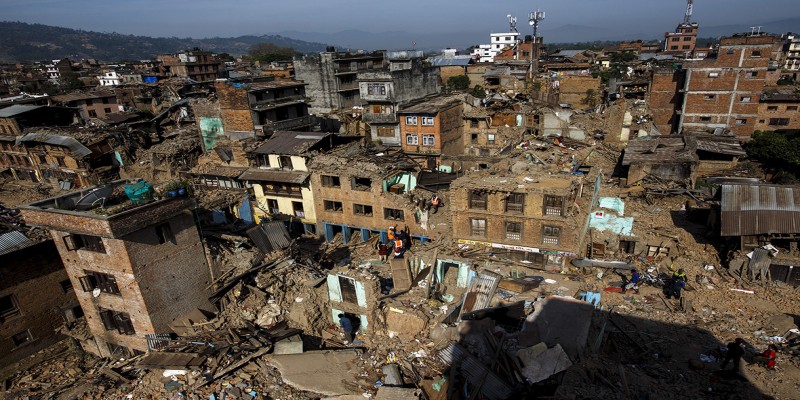
Expenditure Details of #NepalEarthquake Relief Campaigns
2015-05-08 -- HERD
Responding quickly to provide emergency support to earthquake victims, HERD has conducted relief aids distribution campaigns in 6 different locations:
- Jhangajhiti, Kathmandu
- Shankarapur, Kathmandu
- Bimire, Kavre
- Thula Durlung, Lalitpur
- Devitar, Kavre
- Dhusa, Dhading
The table below mentions the total expenditure as of May 17:
Read more
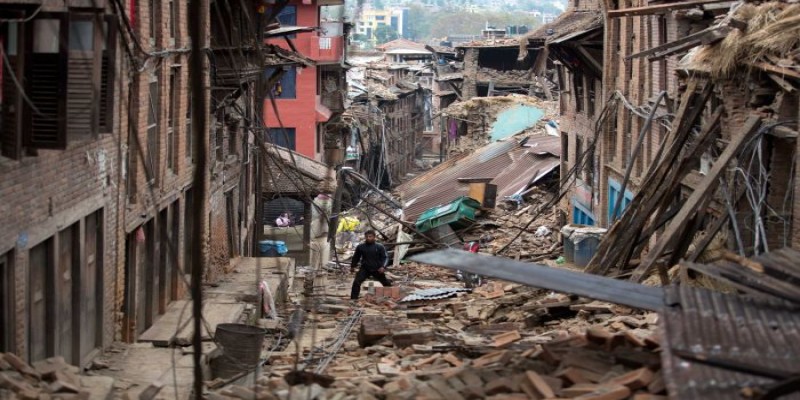
Media Monitoring of #NepalEarthquake - May 7
2015-05-07 -- HERD
The 13th day of the unforgettable calamity has certainly taken its toll with massive media coverage globally and various perspectives from reporting of the statistics to individual stories of grief and victory of death. Today’s media coverage has concentrated over serious concern about epidemic outbreak control, an observation about the positives for Nepal from the Nepal Earthquake, news about expectation of remittance flowing in Nepal and misconducts with regards to distribution of low quality food as relief aids.
Updated Statistics
Republica reports that the total death toll has reached to 7759 with a police report confirming that nine personnel from Nepal Army, 4 from Nepal Police and 1 from Armed Police Force. It also reported that about 11 security personnel, including 10 Nepal Army personnel are still missing. Ekantipur.com reports that the number of people injured in the Saturday quake and the subsequent aftershocks is 16432, as according to the Home Ministry. Relief Web has also provided detailed data in terms of houses destroyed (284,455). Other major statistics mentioned in the infographic shared by the site include:
- 10600 metric tons of rice, sugar, rice, salt, beans and lentils distributed to communities in affected communities
- 14541 classrooms destroyed, 9182 damaged
- 3900 cubic metres of humanitarian cargo for 30 organizations
- 274 national medical teams mobilized by MoHP
- 592 govt. social planners deployed to support relief and recovery operations
- 126,000 children from the age of zero to twenty three months need nutritious food to avoid malnourishment
- 340,513 people provided with water supply by the WASH Cluster. 27,984 people provided with sanitation services
- More than 150 humanitarians from 47 different orgs using internet services provided by ETC Cluster in five locations
- Seven women friendly spaces established in Kathmandu, Bhaktapur, Nuwakot, Kavre and Dhading districts
Caution towards Epidemic Outbreak
There is increased focus towards post disaster epidemic outbreak. BBC has cautioned about various risks of serious disease outbreaks after the disaster. Similarly, Dr. Sameer Mani Dixithas provided some important recommendations highlighting on 3Cs of post disaster epidemic outbreak control-Caution, Containment and Continued Care:
- Open storage systems for water that has collected as a result of rain, or used as reservoirs, should be discouraged. Such reservoirs should be treated to ensure that insects such as mosquitoes do not lay eggs in them.
- In crowded camps that do not have toilets in the vicinity, a simple trench system can be built that empties into a larger closed trench. Temporary enclosures made of bamboo and tarpaulins can be built above the trench to ensure privacy. Once the temporary settlement is no longer required, such trenches can be disinfected and covered with soil.
- To prevent the spread of pathogens, food must be properly cooked, and the consuming of factory-sealed dry food items must be encouraged. In the case of water, drinking only boiled (and cooled as necessary) and/or chlorine-treated water is a sure way of preventing waterborne pathogen infection.
- Even in the most difficult situations, targeted interventions such as communications with the community can be ensured, preventive measures can be put in place and continuous surveillance can be undertaken. This requires the public to be self-aware and needs the government and stakeholders to come together to further support the community. Epidemics will not happen if simple measures are effectively pursued.
Dr. Poonam Khetrapal Singh, WHO Regional Director for South-East Asia is on a visit to Nepal has also reiterated that ramped up efforts are required to boost up health services and expressed her concern about the increased risk of communicable diseases, including diarrhoea, in areas where hygiene and sanitation systems are disrupted as UN News Centrereports.
Rescue, Relief and Reactions
To boost up the relief efforts, USAID has given additional funding of 11 million dollars to assist the Nepal Earthquake response. Trekking Agencies’ Association Nepal (TAAN), 4 bodies of foreigners have been brought to Kathmandu from Langtang, and one of them have been identified as a Malaysian citizen. There are also complaints about low quality food and torn clothes being distributed in the name of relief. Following the destruction of high rise and old buildings in Kathmandu, government has also started inspection of the buildings to gauge the level of destruction and the effort required to rebuild/reconstruct those buildings, Setopatireports. Nepali Times features a story of a very good initiation by mountaineers engaging on cleaning the mountains rather than climbing in the Everest Base Camp as large amount of debris was created in the area following the avalanche blast. Sky News covers a story about taking caution over trafficking of girls after displacement camps set up after the earthquake are being targeted. Oxfam International in its press release has highlighted the importance of rapid response required to provide shelter and proper sanitation before the monsoon begins in June. NASA has claimed that its device called FINDER (Finding Individuals for Disaster and Emergency Response) was used to save lives of 4 people using microwave-radar technology to detect heartbeats of victims trapped in wreckage. Following the April 25 earthquake in Nepal, two prototype FINDER devices were deployed to support search and rescue teams in the stricken area. The Independent reports that Nepal Earthquake victims' families have been prevented from leaving Qatar FIFA World Cup building sites to attend funerals.
Positives from Nepal Earthquake
A Youtube video has highlighted 10 major positives for Nepal after the earthquake:
- People stood united to face it
- Nepal Army takes charge very quickly
- Nepal Police Force works tirelessly
- Exemplary work by Nepal Air Traffic Control to manage domestic and international flights
- Good connection and information broadcasting as Nepal Telecom managed to keep networks and Radio Nepal provided 24/7 coverage
- Free Global community – with waivers on international call charges by Viber, Skype and others
- Good management of electricity with electricity restoration earlier than expected
- Leveraging social media to find people, match resources and requirements with relief delivery
- Overwhelming international support
- Crowd sourcing of funds for relief assistance
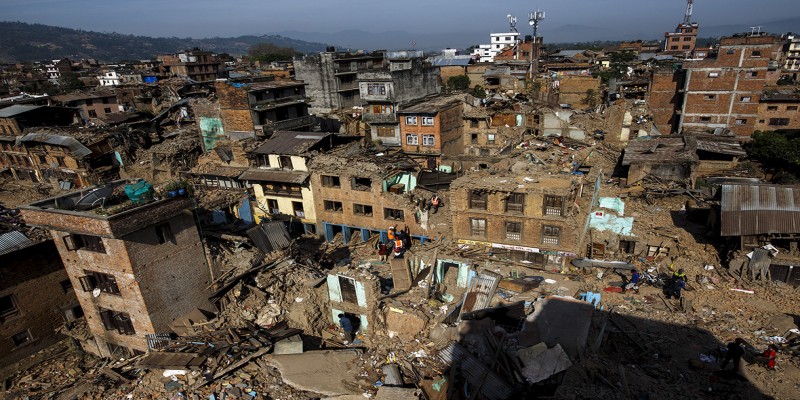
Media Monitoring of #NepalEarthquake - May 6
2015-05-06 -- HERD
12 days since the earthquake and the media coverage gradually shifting gears focusing on rebuilding rather than immediate relief efforts. With hardly any news on rescue of survivors as it has been almost two weeks since the incident, most of the media coverage deal with people’s reactions – raising spirits with the message of Nepal Bounces Back; efforts to prevent disease outbreaks by development organizations and a positive initiative of focus on education with schools gradually opening, conducting classrooms at tents. Major highlights of media coverage:
Relief and Rescue Efforts
As an additional support, China is sending additional IL 76 helicopters to support the relief operations. These helicopters will be used to carry relief materials such as tents, generator and food items, as according to Setopati. On the other hand, other foreign rescue teams are gradually returning following government’s request. Nepal Army reported that 498 military personnel returned on Tuesday belonging to France, Switzerland, Germany, Britian, Belgium, Canada, the Netherlands, Poland, Spain, Turkey, US, Pakistan and India. Nepal Army statistics reveal that a total of 4050 rescues and 129 sniffer dogs from 34 countries arrived to assist the government since April 25. In order to focusing on rebuilding efforts, Republicareports that Chaudhary Group has pledged Rs. 250 million for the support of quake victims.
Relief Web reports that Urban Search and Rescue Team (USAR) has been working extensively in Nepal with 55 teams coordinated by USAR Coordination Cell including 17 international classified teams (INSARAG) totaling 1872 rescue and medical personnel and 118 search dogs. This team worked in19 sectors with full assessments and search and rescue completed. As a result of their great effort, 16 lives were saved, 1182 were provided with medical assistance and178 bodies were recovered in the rescue operations.
As a public health action to prevent epidemic outbreak as well as ensure adequate nutrition for the children, UNICEF is providing 13.5 million sachets of micronutrient powder to young children and also providing clean supply water to 124,482 people with the support of other agencies.
Reactions
Indian media criticism of negative reporting of earthquake hasn’t stopped with CNN report highlighting strong criticism of Indian media ‘insensitivity’ of turning earthquake coverage into a public relations exercise for the Indian government. On the other hand, Hindustan Times, another Indian media has been posting some really interesting news on the earthquake such as an experience of an Indian facing the earthquake and the avalanche during his Everest expedition.
Regarding local public reactions to the disaster, gradually people are turning up to their everyday business and normalcy is setting tone with the positive messages such as these, posted by an individual on Twitter: “Don't lose hope. Let us join together and raise your hand in making new Nepal. Be strong, we will rise again.” There is equally a worrying situation such as for the victims of Lapsiphedi who have started to worry about their future as it is the time to weed the maize field but the villagers are not in a condition to work in the fields as most of the houses of the Tamang village have developed cracks and some of them have been completely damaged. Republica also reports victims of Ramkot begging for relief as the locals are infuriated with the government and feel discriminated not being able to receive any relief supported being so close, 5 kilometres away from the heart of the city.
125 out of 389 schools in Chitwan have been damaged due to earthquake and some schools have already resumed classes under the tents after receiving tents from supporting authorities.
Some public health experts, after observing the relief operations by foreign medical teams have also shared their opinion in British Medical Journal about the challenges in handling foreign medical teams. The challenges, according to them are:
- Lack of information leading to poor decision making
- Hospitals lacking the medical and surgical supplies required to manage the huge number of trauma cases, particularly major orthopaedic surgical interventions
- Difficult geographic terrain of the country and its limited transport options; compelling response/volunteer groups being prepared to walk several hours to days to reach the remote hilly areas to provide services
Politically Incorrect
With the calamity of such a scale, already taking lives of 7652 people and over 200,000 houses being completely destroyed, it is such a shame that political parties are disputing over relief support such as in Nuwakot resulting in relief programmes being stopped for the time being. Taking political advantages is a big no-no at this time of grave humanitarian crisis and we all need to take initiative for a united Nepali rebuilding process.
Read more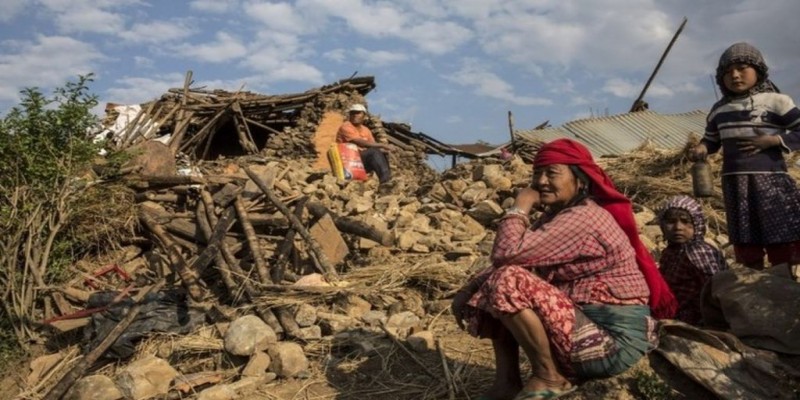
Media Monitoring of #NepalEarthquake - May 5
2015-05-05 -- HERD
It has been 11 days since the earthquake and coverage has been diversified from more personal stories and experiences of earthquake endurance to personal observations of relief efforts. There is also positive news coverage such as a baby of a quake survivor being delivered and Jagadamba Steels showing willingness to rebuild Dharahara. Some media agencies have also reported about statistics on severe destruction to schools and individual homes. Major highlights of today’s media reporting are presented below:
Government Efforts
With the cautioning and realization that a great calamity could cause massive disaster, Republica reports about government’s focus on disaster with the Prime Minister thinking on the lines of a separate ministry for disaster management. Republica also reports that the government plans to construct earthquake resistant buildings while reconstructing demolished and damaged houses. It is also encouraging to hear that the Prime Minister has made a strong statement that the Prime Minister will anyhow manage to distribute the relief material, as reported by Setopati.
Reactions
Despite the good initiation by the government in terms of relief efforts, Pahilo Post reports that the victims of Ramche are waiting for relief materials and so far only one organisation have provided relief aid which according to the locals is not enough. With the realization that it has been utterly difficult for rescue efforts, an individual on Twitter opines that drones need to be extensively used in disaster management for surveillance and delivery. Nepali Timeshas also covered a story on Bungmati that despite being only 20 minutes out of the city by car, residents of Bungamati are struggling to house families in temporary shelters. The report states that the town has only 60 tents for 700 families whose brick and mud homes have been completely destroyed. In order to continue the livelihood and gradually come into normalcy, there are also stories on Twitter regarding resuming of brick kilns even with broken chimneys. BBC also reports that due to the earthquake, the Mount Everest climbs are almost impossible. There is also a great story in The Washington Post regarding an endurance test by Peter Hillary after avalanche in Everest. Rudra Bahadur Karki opines that post-search and rescue phase is one that requires an active government presence. He also shares an important lesson from Haiti is that for sustainable rehabilitation and reconstruction, the presence of the government is critical.
Relief Efforts
Tent shortage in Nepal has prompted response from Dot Earth. Ujyalo 90 network has also provided extensive coverage of earthquake. Doctors without Borders has also done an exemplary work in emergency health care – a beautiful story of a baby being delivered by quake survivors. Holiday Experiences has also dedicated a photo blog on World Heritage Sites being destroyed due to massive earthquake in Nepal. USAID through its special factsheet on earthquake has updated its earthquake related activities such as US delegation led by USAID Acting Administrator Alfonso E. Lenhardt visits Nepal and participating in an aerial survey of affected districts and observe the distribution of emergency relief supplies. USAID also informs that the US government has allocated nearly $15 million to support urban search-and-rescue (USAR) operations and the distribution of food assistance, shelter materials, and other critically-needed relief commodities in Nepal. USAID rescue operations have resulted in 16 successful live rescues and the recovery of 179 bodies from collapsed structures.
To mitigate health risks following the earthquake, disease surveillance personnel are participating in GoN–WHO assessments of affected health facilities, and relief organizations have established disease surveillance for acute diarrhea in IDP sites and affected districts, according to the UN. The GoN is also conducting public health messaging to reduce the risk of disease outbreak. Relief organizations are also providing assistance to mitigate the spread of waterborne diseases, including basic shelter support, hygiene kits, water treatment supplies, and safe drinking water to improve conditions for the Internally Displaced Persons (IDPs).
UNICEF reports that more than half a million children are being targeted in an emergency vaccination drive in Nepal – as fears grow of measles outbreaks in the informal camps that have sprung up since the earthquake on 25 April. Oxfam International is also working in 7 districts: 3 in Ktm valley and 4 in Gorkha, Sindhupalchowk, Nuwakot and Dhading. Setopatireports that after the government’s request, foreign rescue teams have begun to return.
Focus on Education and Reconstruction for Rebuilding Efforts
With BBC News report that there is just a single house remaining in Langtang area which was once home to 435 people; 95 percent of schools in Sindhupalchowk and 62 community schools damaged by quake in Kaski in addition to government suggesting people not to reside in some of the apartments after the inspection, there is a greater need to focus on better reconstruction and education for rebuilding efforts.
Read more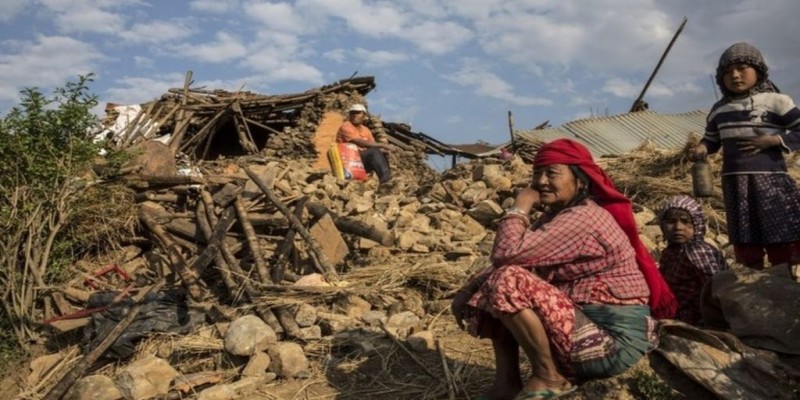
HERD's Relief Efforts Covered by The Himalayan Times
2015-05-05 -- HERD
Relief efforts conducted by HERD have been covered by today's edition of The Himalayan Times.

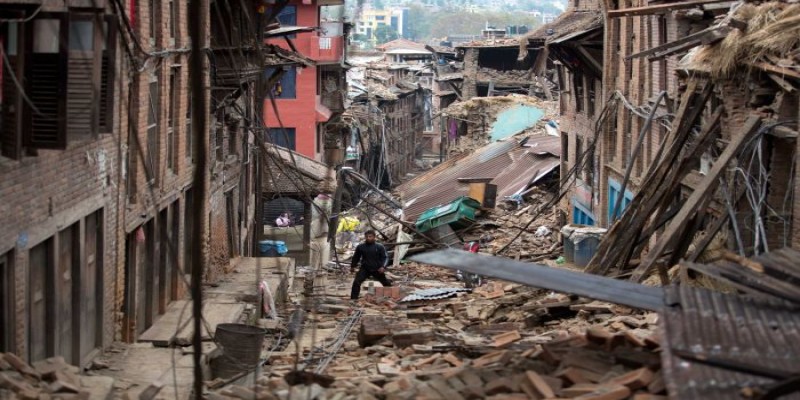
Media Monitoring of #NepalEarthquake - May 4
2015-05-04 -- HERD
10 days on, the media coverage on earthquake in Nepal has mostly concentrated on rebuilding efforts and aid management. Interestingly, with the realization that Nepal needs to go through comprehensive reconstruction, the fundraising efforts have been uniquely innovative such as a visual artist developing a poster that reads, “The Least You Can Do is the Most” while Boise Café hosting benefit cuisines for the victims and Charity Champagne Shopping Night being hosted at Brisbane. Some of the highlights of today’s media reporting are presented below:
Aid Management
European Union has developed a fact sheet which explains that the commission has deployed more humanitarian aid and civil protection experts to the affected areas. Through the Copernicus Emergency Management Service satellite images/maps of the disaster area have been developed to support the rescue operations. There is also European Commission's Emergency Response Coordination Centre monitoring the development of rescue operations. UK Aid through an info-graphic has provided a detailed breakdown of its 22.8 million aid to the earthquake relief and rescue operations with 3 million via DFID’s Rapid Response Facility to six trusted NGOs and charities; 5 million for more medics, humanitarian experts, supplies and heavy lifting equipment for Kathmandu airport; 5 million to the Disaster Emergency Committee; 5.3 million for UN agencies in Nepal; 2.5 million for UN helicopters; 2 million for British Red Cross.
Jumla district alone has collected 1 million rupees for quake victims through various government and non-government agencies. There was also news on Twitter regarding Bangladesh providing 10 metric ton rice and water to Nepal for the quake victims. Human Appeal Australia is also supervising aid distribution in Nepal in order to assess the aid effectiveness. Pahilo Post reports that in order to carry out exploration, rescue and relief efforts, Home Ministry has demanded 50 billion rupees from Prime Minister’s Relief Fund.
Government Efforts
Swasthya Khabar Patrika reports that government has made a strong decision to suspend health workers for not going to affected areas by the government. Republica reports that government has also shown concerns over possible misuse of donations to quake victims. There is also report that government is to table a special resolution motion in the upcoming Parliament session, with a relief and rehabilitation package for the people of the earthquake -hit areas. There has also been a good initiation on the part of the government releasing Rs. 1.35 billion of relief fund to 47 affected districts. There have also been news about government has decided to request foreign search and rescue teams working in Nepal to return home as per the meeting of the Central Natural Disaster Relief Committee on Sunday took a decision to this effect.
Reactions
Despite these encouraging government efforts, the public outrage in Nepal has not stopped yet. Quake victims of Southern belt of Lalitpur have also complained of not getting relief as reported by Republica. An individual on Twitter comments, “Where are all the ministers of Nepal? Helping victims?” New York Times covers an interesting article by Jeffrey D. Sachs on disaster management as he advocates on building up strong disaster management system. Himal South Asian has also dedicated a special issue about human stories from the field.
Relief Efforts
In order to support relief and rescue efforts, Crisis Mappers have been actively contributing by developing their maps with its skype rooms in full swing. Although IndianMediaGoBack hashtag is trending on Twitter amidst wide criticism, Indian reporter Rahul Kanwal provides a comprehensive coverage reporting from ground zero with news on tourists turning into relief workers, valuables at the historical and religious sites being stolen by ‘treasure hunters’, commentary on aid route through government channels; disastrous trend of clicking selfies under the damaged historical sites; and fear syndrome disturbing Nepalese in general. Twitter also displays UNFPA distributing trademark dignity kits to quake affected pregnant women and lactating mothers and Water Aid Nepal launches emergency water and sanitation response for the quake victims. SwasthyaKhabar Patrika also reports Vayodha Hospital providing free of cost treatment to earthquake victims and Basanta Chaudhary Foundationsetting up a special medical camp to prevent outbreak of epidemics in association of Norvic at the Norvic Institute of Technology compound at Lubhu. Setopati also reports some relief aid being provided to the Muslim community. Air Map has also been launched to enable safe, legal and hassle free drone flying to support the rescue and relief efforts.
With 8.2 million people affected by the earthquake, death toll reaching 7365 and 575 schoolsbeing completely damaged, it remains a major challenge as to develop an efficient reconstruction mechanism to promote health and education along with ensuring availability of food, clothes and shelter – the preconditions for survival.
Read more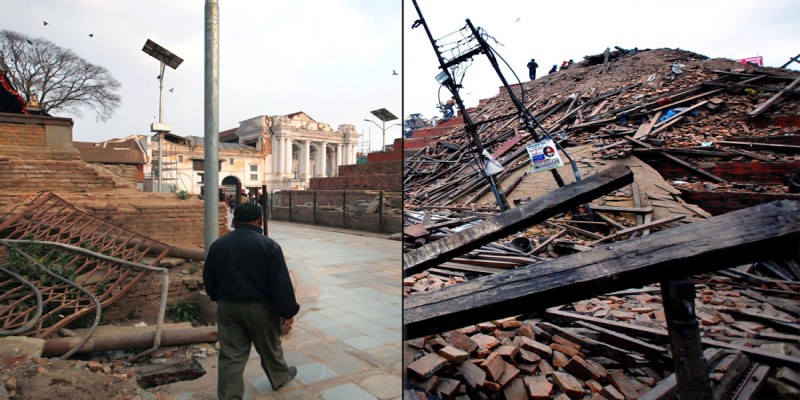
Heartfelt Gratitude to Earthquake Relief Campaign Supporters
2015-05-04 -- HERD
HERD would like to extend its heartfelt gratitude to the following agencies and individuals, supporting us by providing various relief materials and medical supplies:

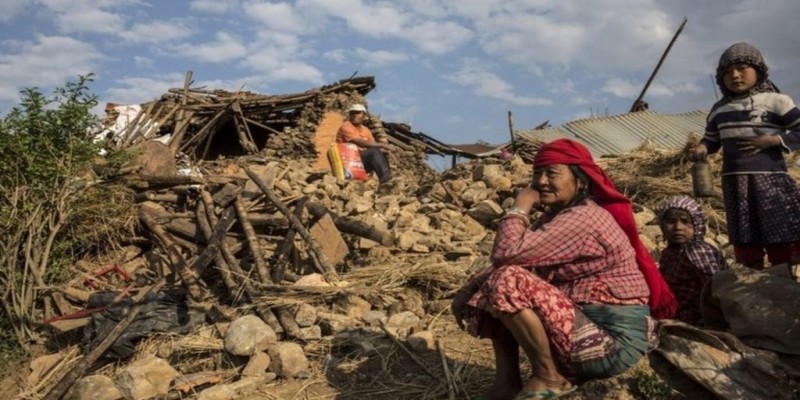
Media Monitoring of #NepalEarthquake - May 3
2015-05-04 -- HERD
With the news on government announcing online deposit provision to Prime Minister’s Relief Fund, day 9 of the earthquake incident in Nepal is a mixed bag in terms of various reactions to relief activities; positive news on rescue of survivors and a negative reaction via Twitter to Indian media reporting of earthquake in Nepal. Some of the highlights of today’s media reporting are presented below:
Caution regarding outbreaks
With growing concern about epidemic outbreaks, some authorities claim that epidemic diseases like cholera cannot be directly caused by an earthquake but a public health concern in the aftermath. In order to spread general awareness about health tips after the earthquake, USAID Nepal has 4 basic tips: do not defecate out in the open; clean hands; find out if your water has been chlorinated; and compost or bury your solid food waste.
Emergency Health Care
Republica reports that a team of doctors from Red Cross has started emergency health care in Dhunche, district headquarters of Rasuwa after the affected victims were airlifted from different parts of the district. On the other hand, as Setopati reports that despite government’s announcement of free medical treatment of earthquake victims, private hospitals got treatment cost back only after a week of the incident.
Aid Management
Today’s media report additional aid support to Nepal with UK releasing 5.3 million pound to aid support package following UN flash appeal. Similarly, Ms. Mamata Banerjee, Chief Minister of West Bengal, India has donated 100,000 tents for the quake victims. For aid logistics management, Radio New Zealand reports that UN has urged Nepal to relax customs controls which it says are holding up deliveries of aid to survivors of last week's earthquake. Relief materials are still landing into Nepal with Republica reporting that a total of 151 flights from 35 countries laden with relief materials touched down at the Tribhuvan International Airport (TIA). Releasing that spinal cord treatment is the major challenge for health service providers; World Health Organization has mobilized its aid for long term spinal cord treatment after Nepal earthquake. Bhaktapur, a highly affected district has provided relief amount to the affected families through its six municipalities. Political parties have also allowed its cadres to distribute relief to the affected victims.
Reactions
Reaction against Indian media reporting of earthquake was most trended today on Twitter as The Hindustan Times reports that with #GoHomeIndianMedia being the top trending hashtag in Nepal. Nepalese Twitter users accused the Indian media of being insensitive to survivors, asking them irrelevant questions such as "How are you feeling?" and not helping those needing immediate medical aid. Other than that, other reactions were related to public dissatisfaction in Bhaktapur with no politicians visiting the affected people in 8 days. There is also realization that more tents are required for the affected victims and government lacks enough tents for immediate shelter as relief. Similarly, people at Gorkha are still waiting for relief support. With fear of continued aftershocks and more destruction in the valley, Setopatireports that 800,000 people left the Kathmandu valley to other districts. Public outrage over government’s lack of seriousness over relief efforts was also reflected in social media such as Twitter as an individual writes, “There is no need for a helipad. You just need will to land.” In order to address strengthened information system for humanitarian causes, Medium.compoints out Eight Critical Dimensions of Information EcoSystems: Information Needs, Information Landscpae, Production & Movement, Access Dynamism, Use of Information, Impact of Information, Social Trust and Influencers.
Rescue Efforts
Interestingly, despite government claims that survivors are difficult to find, BBC reports that 8 Britons stranded in a monastery were rescued by DFID’s emergency team. Similarly, according to OnlineKhabar.com, 3 individuals were successfully rescued from Sindhupalchowk. Ekantipur.com reports an interesting story of a centenarian rescued alive after 8 days from Nuwakot. BBC also reports successful stories of rescue efforts, some champions risking their own lives while rescuing others.
Life after Earthquake
To promote positivity during this difficult time, media have also started disseminating positive public messages such as an Indian singer Gaurav Dagaonkar dedicating a song for the earthquake victims. Nepali Times also covers a story of an elderly who faced two giant earthquakes in his lifetime. Oxfam America also presents a glimpse of life after earthquake through photo series. Car Free Times has also dedicated a Special Edition Nepal's earthquake with detailed pictures of devastation. An informative piece is published by The Economist regarding the scientific causes of why earthquakes occur.
Red Alert
With the death toll rising over 7000 and frequent aftershocks; Sunday morning itself facing 3 after-shocks and Mt. Everest shrinking a bit smaller (2.8 cm) after the earthquake, according to media reports, the days ahead are still challenging. Moreover, UNDP Project Officerspecializing in implementation of safe building codes claims that 80 percent of buildings are owner built and they employ masons not formally trained in building processes.
This has put forward a big question on necessity of managed reconstruction activities not only for mitigating this disaster but also planning ahead for being better prepared for other disasters in the future.
Read more.jpg)
Media Monitoring of #NepalEarthquake - May 2
2015-05-02 -- HERD
With the death toll rising up to 6621 and UN reports of 90 percent homes in Gorkha being damaged, and hospitals in most affected districts being completely destroyed or badly damaged to function, media coverage of earthquake today in Day 8 continues with Nepali authorities ruling out possibility of finding more survivors and general public cautioning over aid mismanagement. With reports of aftershock again in Gorkha, the fear and the trauma of the earthquake hasn’t eroded yet. Major stories covered today are presented below:
Outbreaks
As the days of the earthquake incident are extending organizations working in public health issues such as UNICEF are concerned over heightened risk of cholera and diarrheal diseases. The US Embassy Medical Unit claims that after a natural disaster, deaths are rarely due to infectious diseases and claims that deaths after a natural disaster are caused often due to blunt trauma, crush-related injuries, or drowning. It suggests that water should be boiled or disinfected or use of iodine tablets to avoid contamination. Similarly, to prevent sickness, it has recommended hand washing, avoiding frozen goods (especially meat and fish), treating drinking water and eating only cooked food. A controversial statement was made by Epidemiology and Disease Control Division (EDCD) that no epidemics will over as a result of the earthquake while Swasthya Khabarpatrika today has reported that there is already diarrhea outbreak in Haku VDC of Rasuwa.
Aid Management
It is good news that the fund flow hasn’t stopped but rather increased with Fulkumari Mahato Memorial Trust declared to provide 150 million rupees for relief and reconstruction in the affected districts. Exciting news is that Facebook was able to raise more than 10 million dollars just within two days. USAID alone has provided a total of $12.5 million of support as Humanitarian Assistance to Nepal. From the political front, Nepali Congress party has also pledged to donate 10 million rupees to Prime Minister’s Relief Fund for the earthquake victims.
With all these fundraising efforts, there has been criticism about government’s one-door relief fund policy as it has resulted in delay of aid distribution. Another concern is related to aid transparency with an online petition being launched to audit and investigate earthquake fund in Nepal.
Government Efforts
As a reaction to criticisms regarding aid management, the Chief of Army Staff opined that the coordination of foreign aid relief has been satisfactory given the extent of aid flowing and the nature of the calamity. Finance Minister via his personal Twitter account also clarified that relief materials coming from abroad will not be taxed. However, he also expressed that it is the duty of the government to have strict vigilance over its misutilization. In order to make drugs available for emergency health treatment of quake victims, Department of Drug Administration has requested drug retailers to make available drugs immediately. Republicareports that for the quake victims in the 253 VDCs of five most affected districts, the government has also announced to provide grant of Rs. 900,000 each. The daily also reports that the government has started damage assessment for buildings in the capital.
Public Reactions
Public reactions as reflected in the media today deal with criticism over statement of government authorities that there is remote possibility of finding survivors while the government not being able to reach out in rescue operations in remote places in the villages. Noodles are being extensively used as immediate relief food item for the survivors and therefore there was a concern raised by an individual that noodles industry should be tax free during this period. Sindhupalchowk is the most affected district in terms of deaths, injuries and damages of houses, as a result the aid has been pouring in the district. However, the locals there suspect corruption and request anyone willing to provide them relief to be directly hand over the relief items rather than through any agency. In social media, there has also been a lot of debate and discussion on government’s efforts in aid management – one narrative criticizing government’s efforts and the other narrative supporting the same. An individual through his personal Twitter account recommends for more action and less talk as he requests, “Please stop this sickening narrative. Internationals good, Nepal government bad. No one stopping anyone from helping. Do now, talk later please.”
Innovative Relief/Rescue Efforts
With the days prolonging, the relief and rescue efforts have also been continuous. New York Times reports that Nepalese through the extensive use of internet have been using 3 specific methods to aid in quake relief: Open Mapping, Crowd Funding and Volunteer Coordination. India Today presents that in order to help manage growing piles of relief supplies clogging Tribhuvan International Airport, US Military Aircraft, Heavy Equipment and Air Traffic Controllers are arriving in Nepal today though World Food Programme claims that there is systematic logistics management at Kathmandu airport as reported by the IRIN News. Humane Society International is taking care of animals abandoned or injured in Nepal Earthquake.
Bhaktapur, an ancient city enriched with cultural heritage has been completely destroyed due to earthquake. India Times reveal that the Bhaktapur residents are not keen on using cranes and they are collecting debris using bare hands. They say that use of cranes will destroy the artwork.
Harvard Humanitarian Initiative of Harvard University has been supporting the earthquake relief efforts by using Kobo Toolbox for realtime data collection and sharing system and working with Crisis Mappers Network to establish a map of needs in the region. HHI's Signal Program is also supporting the mapping of IDP camp locations with satellite imagery. Beth Israel Disaster Medicine Team and The Massachussets General Hospital Department of Emergency Medicine are also providing medical treatment to the quake victims.
Israeli Army has set up a makeshift hospital in Chhauni and has been providing health treatment. A baby was born today in the hospital, as shared by an individual via Twitter. Sankhu a highly affected place in the outskirts of Kathmandu has been entertaining scores of NGOs and INGOs as it is near to Kathmandu and there has been public concerns over difficulty in relief operations due to crowd of onlookers. To avoid similar problem and also to provide immediate relief to the people who are in utmost need of shelter, USAID reports that it is planning to airlift plastic sheeting and materials for shelter.
Maternal and Child Health
Women and children are the most vulnerable population that need special care and attention at this moment. Save the Children presents a staggering figure of 260000 children being homeless after the earthquake while e-kantipur.com provides a figure of 60000 pregnant and new mothers been badly affected by the earthquake. UNICEF has set up child-friendly open spaces in Kathmandu in order to address their issues of trauma and helplessness during this period.
The Way Forward
With the massive earthquake in Nepal, UNDP is reflecting on its efforts towards disaster management in vulnerable countries and with the nature and scale of destruction, the Nepal experience could be a good lesson learnt for effective disaster management.
With the death toll rising up to 6621 and UN reports of 90 percent homes in Gorkha being damaged, and hospitals in most affected districts being completely destroyed or badly damaged to function, media coverage of earthquake today in Day 8 continues with Nepali authorities ruling out possibility of finding more survivors and general public cautioning over aid mismanagement. With reports of aftershock again in Gorkha, the fear and the trauma of the earthquake hasn’t eroded yet. Major stories covered today are presented below:
Outbreaks
As the days of the earthquake incident are extending organizations working in public health issues such as UNICEF are concerned over heightened risk of cholera and diarrheal diseases. The US Embassy Medical Unit claims that after a natural disaster, deaths are rarely due to infectious diseases and claims that deaths after a natural disaster are caused often due to blunt trauma, crush-related injuries, or drowning. It suggests that water should be boiled or disinfected or use of iodine tablets to avoid contamination. Similarly, to prevent sickness, it has recommended hand washing, avoiding frozen goods (especially meat and fish), treating drinking water and eating only cooked food. A controversial statement was made by Epidemiology and Disease Control Division (EDCD) that no epidemics will over as a result of the earthquake while Swasthya Khabarpatrika today has reported that there is already diarrhea outbreak in Haku VDC of Rasuwa.
Aid Management
It is good news that the fund flow hasn’t stopped but rather increased with Fulkumari Mahato Memorial Trust declared to provide 150 million rupees for relief and reconstruction in the affected districts. Exciting news is that Facebook was able to raise more than 10 million dollars just within two days. USAID alone has provided a total of $12.5 million of support as Humanitarian Assistance to Nepal. From the political front, Nepali Congress party has also pledged to donate 10 million rupees to Prime Minister’s Relief Fund for the earthquake victims.
With all these fundraising efforts, there has been criticism about government’s one-door relief fund policy as it has resulted in delay of aid distribution. Another concern is related to aid transparency with an online petition being launched to audit and investigate earthquake fund in Nepal.
Government Efforts
As a reaction to criticisms regarding aid management, the Chief of Army Staff opined that the coordination of foreign aid relief has been satisfactory given the extent of aid flowing and the nature of the calamity. Finance Minister via his personal Twitter account also clarified that relief materials coming from abroad will not be taxed. However, he also expressed that it is the duty of the government to have strict vigilance over its misutilization. In order to make drugs available for emergency health treatment of quake victims, Department of Drug Administration has requested drug retailers to make available drugs immediately. Republicareports that for the quake victims in the 253 VDCs of five most affected districts, the government has also announced to provide grant of Rs. 900,000 each. The daily also reports that the government has started damage assessment for buildings in the capital.
Public Reactions
Public reactions as reflected in the media today deal with criticism over statement of government authorities that there is remote possibility of finding survivors while the government not being able to reach out in rescue operations in remote places in the villages. Noodles are being extensively used as immediate relief food item for the survivors and therefore there was a concern raised by an individual that noodles industry should be tax free during this period. Sindhupalchowk is the most affected district in terms of deaths, injuries and damages of houses, as a result the aid has been pouring in the district. However, the locals there suspect corruption and request anyone willing to provide them relief to be directly hand over the relief items rather than through any agency. In social media, there has also been a lot of debate and discussion on government’s efforts in aid management – one narrative criticizing government’s efforts and the other narrative supporting the same. An individual through his personal Twitter account recommends for more action and less talk as he requests, “Please stop this sickening narrative. Internationals good, Nepal government bad. No one stopping anyone from helping. Do now, talk later please.”
Innovative Relief/Rescue Efforts
With the days prolonging, the relief and rescue efforts have also been continuous. New York Times reports that Nepalese through the extensive use of internet have been using 3 specific methods to aid in quake relief: Open Mapping, Crowd Funding and Volunteer Coordination. India Today presents that in order to help manage growing piles of relief supplies clogging Tribhuvan International Airport, US Military Aircraft, Heavy Equipment and Air Traffic Controllers are arriving in Nepal today though World Food Programme claims that there is systematic logistics management at Kathmandu airport as reported by the IRIN News. Humane Society International is taking care of animals abandoned or injured in Nepal Earthquake.
Bhaktapur, an ancient city enriched with cultural heritage has been completely destroyed due to earthquake. India Times reveal that the Bhaktapur residents are not keen on using cranes and they are collecting debris using bare hands. They say that use of cranes will destroy the artwork.
Harvard Humanitarian Initiative of Harvard University has been supporting the earthquake relief efforts by using Kobo Toolbox for realtime data collection and sharing system and working with Crisis Mappers Network to establish a map of needs in the region. HHI's Signal Program is also supporting the mapping of IDP camp locations with satellite imagery. Beth Israel Disaster Medicine Team and The Massachussets General Hospital Department of Emergency Medicine are also providing medical treatment to the quake victims.
Israeli Army has set up a makeshift hospital in Chhauni and has been providing health treatment. A baby was born today in the hospital, as shared by an individual via Twitter. Sankhu a highly affected place in the outskirts of Kathmandu has been entertaining scores of NGOs and INGOs as it is near to Kathmandu and there has been public concerns over difficulty in relief operations due to crowd of onlookers. To avoid similar problem and also to provide immediate relief to the people who are in utmost need of shelter, USAID reports that it is planning to airlift plastic sheeting and materials for shelter.
Maternal and Child Health
Women and children are the most vulnerable population that need special care and attention at this moment. Save the Children presents a staggering figure of 260000 children being homeless after the earthquake while e-kantipur.com provides a figure of 60000 pregnant and new mothers been badly affected by the earthquake. UNICEF has set up child-friendly open spaces in Kathmandu in order to address their issues of trauma and helplessness during this period.
The Way Forward
With the massive earthquake in Nepal, UNDP is reflecting on its efforts towards disaster management in vulnerable countries and with the nature and scale of destruction, the Nepal experience could be a good lesson learnt for effective disaster management.
Read more